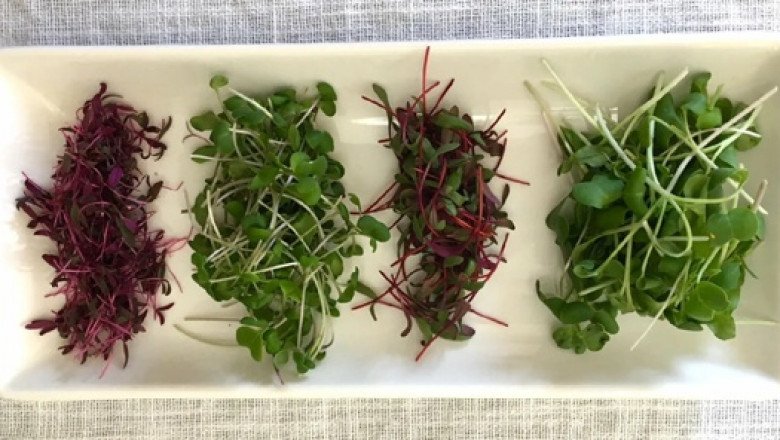views
Nutritional Value of Microgreens
Microgreens are the early vegetable seedlings that are usually harvested within 12-14 days after seeding. They pack high amounts of vitamins, minerals, antioxidants and other beneficial plant compounds in very small packages. Microgreens are 3 to 6 times more nutritious than their mature vegetable counterparts. Many studies have shown that microgreens contain significantly higher levels of vitamin K, vitamin C, vitamin A, polyphenols and other antioxidants compared to mature veggies. They are an excellent source of vitamin K which is essential for blood clotting and bone health. Just one ounce of many microgreen varieties provides more than 100% of the recommended daily value of vitamin K.
Ease of Growing Microgreens
Microgreens can be grown easily both indoors or outdoors on a kitchen windowsill or countertop without requiring much space. All they need is potting soil or coconut coir, some seeds and sunlight. Common microgreen varieties like arugula, broccoli and pea shoots germinate within 3-5 days. Radish, mustard, kale and cabbage micros take a little longer around 7 days to sprout. Protecting young microgreens from harsh sunlight during the sprouting stage ensures higher germination rates. It is important to provide adequate moisture during growth. Microgreens can be grown right in reused food containers or plastic propagation trays.
Wide Range of Flavorful Varieties
There are over 50 different microgreen varieties available today with interesting flavors, colors and textures. Popular choices are pea shoots with their sweet pea flavor, arugula with spicy peppery zing, broccoli micros imparting subtle broccoli taste. Other common varieties include radish, watercress, beetroot, sunflower, kale, celery and pak choy microgreens. Micro basil, dill and cilantro offer great herb flavors. Less explored options are fennel, cabbage, coriander and amaranth micros. Combining two or more microgreen varieties in a blend results in new layered flavor profiles to be used in salads and dishes. Their delicate textures and intense flavors make microgreens a standout ingredient.
Versatile Use of Microgreens in Cooking
Due to their size, microgreens can be used as flavorful herb garnishes or toppings on canapes, sandwiches, salads or pizza. They pep up simple scrambled eggs, fried rice or pastas. Microgreens add visual appeal and fresh flavors to soups, stews and curries when added towards the end of cooking. Many cheese and charcuterie platters are enhanced with micros. Their nutritional benefits can also be enjoyed by using microgreens as tea replacements. Blending microgreens into smoothies, pesto or compound butters extends their applications. Adding a handful to salads boosts nutrients while taking the flavors to the next level. Restaurants consider microgreens as an affordable, lowmaintenance and fast-growing ingredient.
Growing Microgreens as a Business
The market for locally-grown specialty microgreens is increasing due to more awareness of their superior nutrition and flavors. Many urbanites, especially health-conscious consumers, are willing to pay premium prices for living greens. The microgreens industry offers opportunities for small business startups. A microgreens farm requires very small space using vertical growing techniques including stackable shelving or racking systems. Short crop cycles allow farmers to make multiple harvests within four weeks. With year-round production possible under proper setup, regular cash flows can be maintained. Selling microgreens to high-end restaurants and grocery stores at a good price-per-ounce allows micro-farmers living income. With small investments and operating costs, growing microgreens sustainably and organically can yield big returns.
Get this Report in Japanese Language:
Get this Report in Korean Language:
About Author:
Money Singh is a seasoned content writer with over four years of experience in the market research sector. Her expertise spans various industries, including food and beverages, biotechnology, chemical and materials, defense and aerospace, consumer goods, etc. (https://www.linkedin.com/in/money-singh-590844163)






















Comments
0 comment